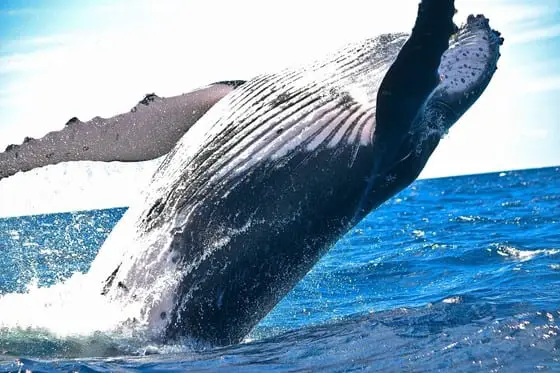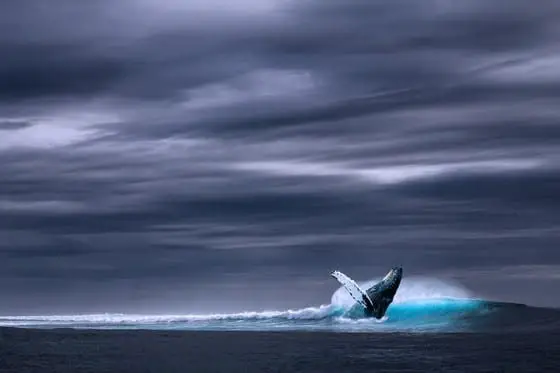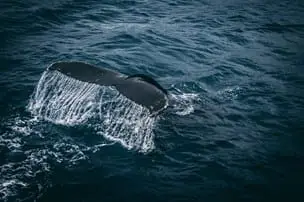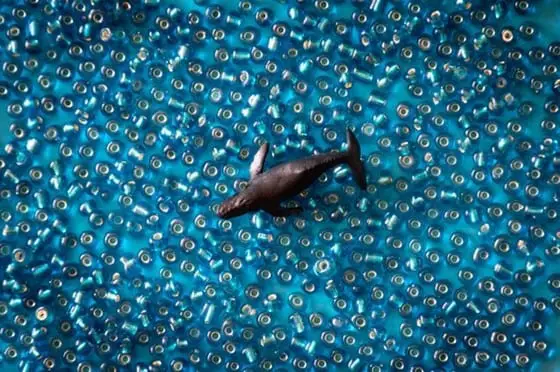
The blue whale is probably the largest animal to have ever lived on the planet. The blue whale is a baleen whale that belongs to the group of fin whales. The baleen whales do not have teeth, but bards, which they use to filter out food from the seawater.
Its tongue can weigh as much as an elephant, its heart is as big as a car, and the aorta (main artery) has a diameter of approx. 20. Here, we talk about some other interesting facts about this giant creature and one of the rare blue objects to have ever existed.
Characteristics
The blue whale has a mottled, blue-grey color on its body and on the side fins (cranks), and is generally lighter than all the other species in the fin whale family. The cranks have a lighter grey-white color on the underside. The abdomen often gets a yellow tint due to millions of microorganisms that reside in the skin. From the mouth and some distance down towards the belly, the blue whale has 60 to 90 belly furrows.
These allow the entire oral cavity to expand almost like an accordion. The head of these blue objects is wide and flat with a double blowhole on top. The body is streamlined and tapers towards the tail fin. The dorsal fin is small and sits far back on the body. The bards are blue-black and count 270-395 on each side of the upper jaw. When the blue whale comes to the surface after a dive, it blows out old air. This “blow column” goes 10-12 meters vertically up in the air!
The tail fin is unique to each whale, just like human fingerprints. The females are slightly larger than the males.
From the mouth and some distance down towards the belly, the blue whale has belly furrows. These allow the entire oral cavity to expand almost like an accordion.
Habitats and distribution
These most fascinating blue objects lives in waters in both the northern and southern hemispheres. The blue whales in the southern hemisphere are slightly larger than their relatives in the north.
Exactly where the blue whales stay changes with the distribution and occurrence of krill. In winter, the blue whale moves towards the equator.
The blue whale is at the top of the food chain and thus plays an important role in maintaining the natural balance in marine ecosystems.

The life of the blue whale
Blue whales usually swim alone, but sometimes can swim in pairs. In areas with a lot of food you can find even more together. Blue whales have a social behavior, but they do not form flocks in the normal way. Although we often talk about animals that live in certain areas and migrate over large distances between summer grazing and winter grazing. When the blue whale moves, these animals usually swim in small groups of 2-4 animals or alone.
The blue whale normally swims at a speed of approx. 3–6 km / h when eating, but can probably reach a top speed of more than 30 km / h over a short distance. Some experts claim that it can reach a speed up to 48.3 km / h. Researchers have confirmed that it is fastest when hunted by predators, such as killer whales that hunt calves. So, when they eat, the blue whale swims between 3 to 6 km/h. If they become frightened or nervous, they can reach 30-50 km/h over short distances. The blue whale can also dive all the way down to a depth of 500 meters and hold its breath for a full 20 minutes.
They communicate with each other through low-frequency sounds – so low that we humans cannot hear them. The low frequency also means that the sounds travel enormous distances in water. It is assumed that the blue whales, under good conditions, can hear each other at a distance of up to 1600 kilometers. The blue whale is also known as “the world’s loudest animal” and their sound level can exceed 150 decibels.
Scientists believe that the blue whale not only uses the sounds to communicate with each other, but also to navigate the silent depths of the sea.
The only animal known to attack the blue whale is the killer whale. The blue whale is one of the earth’s longest-living animals. The oldest registered individual was around 110 years old. The average lifespan is around 80 to 90 years.
Distribution

Before whaling began, there was the largest population of blue whales (probably between 202,000 and 311,000 animals) in Antarctica. But in this area, it is assumed that today there are only a few hundred animals left. In the southern hemisphere, there has also been no rising trend in populations.
In 1998, it was estimated that there were 11 different populations of blue whales around the world’s oceans. These were divided into four regions: the North Pacific- North Atlantic- the northern Indian Ocean; and the southern hemisphere. However, the total population of blue whales is difficult to estimate, but it is estimated that it is between five and twelve thousand animals.
The North Pacific Ocean has the largest concentration of blue whales off the coast of California and Mexico. This is the largest concentration of blue whales in the world. The population has also shown an increasing trend recently. But this trend does not seem to have any significance for the areas around Japan and in the Bering Strait, where these animals were previously numerous. Blue whales are also found around Canada, both north of the Pacific Ocean and north of the North Atlantic.
The Norwegian Polar Institute estimates the total population at approximately six thousand animals, of which approximately 1,000 animals in the Northeast. Only parts of the population (perhaps a few hundred animals) visit Norwegian waters, at certain times of the year. In the Atlantic, blue whales are known to migrates as far north as to Baffin Bay in the west and Spitsbergen in the east in summer. But otherwise little is known about the migration routes, other than that it migrates south in winter. The Icelandic tribe has shown an increasing trend, but otherwise there is no sign of an increase in this population.
In the Indian Ocean, it was estimated in 1996, that there were about 400 pygmy blue whales in an area south of Madagascar. But there are still no reliable estimates for the total population. Some also believe that there is a tribe of pygmy blue whales in the areas around Sri Lanka, the Maldives and along the coast of Oman, but there are no estimates. There is also a tribe of Arctic blue whales in the Indian Ocean. It is also difficult to distinguish pygmy blue whales from immature southern blue whales in the Indian Ocean and southwards, which makes it difficult to determine the size of the total population.

The population of blue whales in Antarctica is uncertain. Estimates range from a few hundred animals to about 8,000, often 50/50 between Arctic blue whales and pygmy blue whales.
Reproduction
Blue whale females become sexually mature when they are around eight to 10 years old, males when they are between 10 and 13 years old. Mating takes place in the winter and the females give birth to one calf, sometimes twins, after a 10-12 month gestation period.
Already like newborn calves, blue whales are ranked as one of the largest animals on earth: about seven meters long and three tons heavy. For the first seven to eight months, it drinks nothing but mother’s milk, and puts on about 90 kg every day. After this, the calf is weaned with breast milk and finally leaves the mother. At this time, the calf can weigh more than 17 tons.
Diet
The blue whale’s diet consists almost exclusively of krill, which are 1-2 centimeters in size, shrimp-like animals. When the blue whale eats, it draws in a huge mouthful of water by expanding the “accordion skin” on its neck and stomach. Using the tongue, it pushes the water out through the bards in the upper jaw and thousands of krill are left in the blue whale’s mouth – ready to be swallowed.
At certain times of the year, an adult blue whale can eat about four tons of krill a day.
Threats
Hunting
Due to its size, the blue whale became the most sought after species among whalers, and the species became almost extinct as a result of commercial whaling. From the beginning of the 20th century until it was protected, more than 10,000 blue whales were caught in the North Atlantic, and around 350,000 in the Southern Ocean. The blue whale was protected in the North Atlantic in 1955, and in the Southern Ocean in 1966.
Today, the population is on the rise again, but due to the enormous taxation in the 20th century, the blue whale is still critically endangered.
Climate changes
Although commercial whaling no longer represents a threat, the impact of climate change on krill makes the blue whale particularly vulnerable.
Other threats
Like other large whale species, the blue whale is threatened by environmental changes, including loss of habitat and acidification of the sea. These blue objects can also be damaged by collisions with ships and by being entangled in fishing gear and marine litter.



